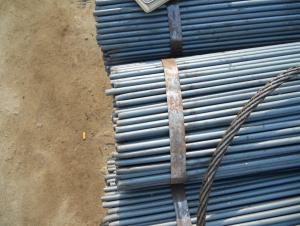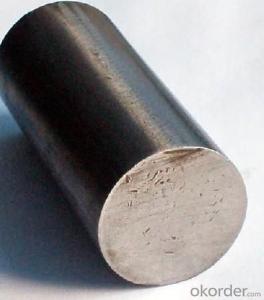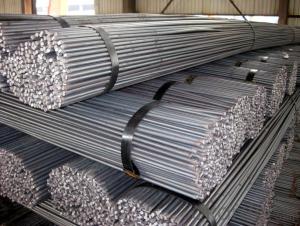GB Standard Steel Round Bar
- Loading Port:
- China Main Port
- Payment Terms:
- TT OR LC
- Min Order Qty:
- -
- Supply Capability:
- -
OKorder Service Pledge
OKorder Financial Service
You Might Also Like
Specifications of Steel Round Bar:
1. Standard: GB
2. Grade: Q345
3. Invoicing on theoretical weight or actual weight as customer’s request
4. Shape: Round bar, solid bar of steel with circular section
5. Technique: Hot rolled
Size:
| Size (mm) | Section Area (cm2) | Mass (Kg/m) |
| 13 | 132.665 | 1.04 |
| 14 | 153.86 | 1.21 |
Packaging & Delivery of Steel Round Bar:
Packaging Detail: Standard seaworthy packing or as customer required; all goods are packed in bundle with steel strips and shipped by break bulk vessel or container
Delivery Detail: 45 days
Trade terms: FOB, CFR, CIF or as customer required
MOQ: 25 tons per specification; we can negotiate the quantity if the specification is normal or we have stock of one specification.
Weight: The price invoicing on theoretical weight basis or actual weight basis depends on customer’s request.
Shipment: The shipment of bulk break or container is depends on customer’s request.
Documents given: Full set (3/3) of original clean on board bill of lading; Original signed commercial invoice, in 3 originals and 3 copies; Original packing list in 3 originals and 3 copies; Policy of insurance; Certificate of origin and what the target market needs.
* If you would like to get our price, please inform us the size, standard/material and quantity. Thank you very much for your attention.
- Q:Can steel round bars be heat treated to enhance their properties?
- Yes, steel round bars can be heat treated to enhance their properties. Heat treatment is a process of heating and cooling the steel in a controlled manner to alter its microstructure, which in turn improves its mechanical properties such as strength, hardness, toughness, and ductility. There are several heat treatment methods that can be applied to steel round bars, depending on the desired outcome. One common method is quenching and tempering. In this process, the steel is heated to a high temperature to form a uniform austenitic structure, and then rapidly cooled by quenching it in a medium such as oil or water. This rapid cooling transforms the austenite into a harder and stronger structure called martensite. However, martensite can be brittle, so the steel is then tempered by reheating it to a lower temperature, which reduces the brittleness and increases toughness while maintaining the desired hardness. Another heat treatment method is annealing, where the steel is heated to a specific temperature and then slowly cooled to relieve internal stresses and improve ductility. This process can also refine the grain structure of the steel, resulting in improved machinability and formability. In addition, there are other heat treatment methods such as normalizing, stress relieving, and case hardening, each designed to enhance specific properties of the steel round bars. Overall, heat treatment is a versatile and effective technique to enhance the properties of steel round bars, allowing them to meet specific requirements for various applications in industries such as manufacturing, construction, automotive, and aerospace.
- Q:Are steel round bars suitable for the manufacturing of shafts?
- Indeed, steel round bars prove to be fitting for the production of shafts. Renowned for their robustness, longevity, and capacity to endure immense loads and rapid rotations, steel round bars excel in applications involving shafts. The circular form of the bar fosters even distribution of stress, thereby diminishing the likelihood of failure or distortion. Moreover, steel round bars can be easily manipulated and subjected to heat treatment in order to attain desired mechanical properties, such as hardness and toughness, thereby reinforcing their aptness for shaft production. All in all, steel round bars encompass the essential attributes demanded by shafts, thereby rendering them a trustworthy and widely employed material in diverse industries.
- Q:Can steel round bars be used for making molds?
- While steel round bars can be utilized in mold production, they may not be the most customary or optimal choice of material. Typically, steel round bars find application in structural or support roles. In the realm of mold fabrication, other materials such as silicone, aluminum, or specific steel molds are generally favored. These alternatives provide superior resistance to heat, flexibility, and convenience for molding purposes. Nevertheless, if the steel round bars are appropriately machined, shaped, and treated, they can still serve in fashioning uncomplicated molds for specific applications. However, prior to employing steel round bars, it is crucial to consider the mold's specific requirements, including the material being molded, the temperature and pressure conditions, and the desired final product finish.
- Q:Can steel round bars be used in the manufacturing of office furniture?
- Yes, steel round bars can be used in the manufacturing of office furniture. Steel is a versatile and durable material that can be shaped into various forms, including round bars. These round bars can be used as structural components in office furniture, such as table legs, chair frames, or support beams. Steel round bars provide strength and stability to the furniture, making it suitable for heavy use in office environments. Additionally, steel can be finished in different ways, such as powder coating or chrome plating, to enhance its appearance and match the aesthetic of the office space. Overall, using steel round bars in the manufacturing of office furniture offers durability, stability, and a modern look.
- Q:Which steel wire is the same diameter as round steel more resistant to breaking?
- Round bar is divided into three parts: hot rolling, forging and cold drawing. Standard Specification for hot rolled round steel is 5.5-250 mm. Of which: 5.5-25 mm of small round bars, mostly straight line bundles of supplies, commonly used as steel, bolts and various mechanical parts; more than 25 millimeters of round steel.
- Q:What are the different types of heat treatments used for steel round bars?
- Steel round bars can undergo various heat treatments to enhance their physical and mechanical properties for specific uses. 1. Annealing: To improve ductility and ease of workability, the steel is heated to high temperatures and gradually cooled, typically in a furnace. This relieves internal stresses and reduces the likelihood of cracking. 2. Normalizing: Similar to annealing, normalizing involves heating the steel to high temperatures and allowing it to cool in still air. This process refines the grain structure, leading to improved strength and toughness. 3. Quenching and tempering: This treatment involves rapidly cooling the steel after heating it to high temperatures, using liquids like oil or water. Quenching hardens the steel, increasing its strength and resistance to wear and deformation. However, this process can render the steel brittle, so tempering follows, which entails reheating the steel to lower temperatures and gradually cooling it. Tempering reduces brittleness while maintaining strength. 4. Case hardening: This treatment creates a hardened outer layer on the steel's surface while preserving a softer, more ductile core. By heating the steel with a carbon-rich material like charcoal or gas, carbon diffuses into the surface, forming a wear-resistant layer. The core remains tough and able to withstand shocks. 5. Stress relieving: This treatment alleviates internal stresses resulting from manufacturing processes like machining or welding. The steel is heated below its critical point and slowly cooled, effectively reducing residual stresses and enhancing dimensional stability. These represent only a selection of the common heat treatments employed for steel round bars. The choice of treatment depends on the desired properties and intended applications of the steel.
- Q:Are steel round bars resistant to chemicals or acids?
- Yes, steel round bars are generally resistant to chemicals and acids due to their high corrosion resistance properties. However, the level of resistance may vary depending on the specific type of steel and the concentration and temperature of the chemicals or acids involved.
- Q:What are the different types of steel round bars used in the manufacturing of valves and fittings?
- There are several different types of steel round bars commonly used in the manufacturing of valves and fittings. These include: 1. Carbon Steel Round Bars: Carbon steel round bars are the most commonly used type of steel in valve and fitting manufacturing. They are known for their strength, durability, and ability to withstand high temperatures and pressures. 2. Stainless Steel Round Bars: Stainless steel round bars are highly resistant to corrosion, making them ideal for use in valves and fittings that come into contact with liquids or gases. They are also known for their high strength and excellent mechanical properties. 3. Alloy Steel Round Bars: Alloy steel round bars are made by adding various alloying elements such as chromium, manganese, and nickel to carbon steel. This enhances their strength, hardness, and resistance to wear and tear, making them suitable for use in demanding valve and fitting applications. 4. Duplex Steel Round Bars: Duplex steel round bars are a type of stainless steel that contains a balanced mix of ferrite and austenite phases. This gives them a unique combination of excellent strength, corrosion resistance, and resistance to stress corrosion cracking, making them suitable for use in valves and fittings exposed to harsh environments. 5. Nickel Alloy Round Bars: Nickel alloy round bars are known for their exceptional resistance to corrosion and high-temperature applications. They offer excellent mechanical properties and are commonly used in valves and fittings that handle corrosive fluids or operate in extreme temperatures. It is important to select the appropriate type of steel round bar for valve and fitting manufacturing based on the specific requirements of the application, considering factors such as pressure, temperature, fluid compatibility, and environmental conditions.
- Q:How do steel round bars compare to copper round bars?
- Different applications call for distinct properties in steel and copper round bars. To begin with, steel round bars are known for their remarkable strength and durability. This versatile material can withstand high levels of stress, making it perfect for structural and industrial uses. With its high tensile strength, steel can resist pulling forces without breaking. Construction projects, automotive components, and machinery manufacturing frequently rely on steel round bars. On the other hand, copper round bars possess unique characteristics that set them apart from steel. Copper is an exceptional conductor of heat and electricity, making it indispensable in electrical wiring and plumbing systems. Its high resistance to corrosion makes copper pipes widely used in plumbing applications. Additionally, copper's antimicrobial properties make it a preferred material for medical equipment and food processing industries. When it comes to cost, steel round bars tend to be more affordable than copper round bars. Steel is abundantly available and has lower production costs compared to copper. This cost advantage makes steel a popular choice for budget-conscious applications. In terms of appearance, steel round bars have a sleek, metallic finish, while copper round bars exhibit a distinct reddish-brown appearance. This visual distinction often influences the selection of materials in architectural and decorative applications. In summary, steel round bars and copper round bars possess different properties that suit them for specific purposes. Steel offers exceptional strength and durability, making it suitable for structural and industrial applications. Copper, on the other hand, is valued for its conductivity, corrosion resistance, and antimicrobial properties, making it ideal for electrical, plumbing, and medical applications. The choice between steel and copper depends on the specific requirements of the project and the desired properties of the material.
- Q:Can steel round bars be used for making brake components?
- Yes, steel round bars can be used for making brake components. Steel is a common material used in the manufacturing of brake components due to its high strength, durability, and resistance to heat and corrosion. Steel round bars can be machined and formed into various shapes required for brake components such as brake rotors, brake caliper brackets, or brake pedal levers.
1. Manufacturer Overview |
|
|---|---|
| Location | |
| Year Established | |
| Annual Output Value | |
| Main Markets | |
| Company Certifications | |
2. Manufacturer Certificates |
|
|---|---|
| a) Certification Name | |
| Range | |
| Reference | |
| Validity Period | |
3. Manufacturer Capability |
|
|---|---|
| a)Trade Capacity | |
| Nearest Port | |
| Export Percentage | |
| No.of Employees in Trade Department | |
| Language Spoken: | |
| b)Factory Information | |
| Factory Size: | |
| No. of Production Lines | |
| Contract Manufacturing | |
| Product Price Range | |
Send your message to us
GB Standard Steel Round Bar
- Loading Port:
- China Main Port
- Payment Terms:
- TT OR LC
- Min Order Qty:
- -
- Supply Capability:
- -
OKorder Service Pledge
OKorder Financial Service
Similar products
New products
Hot products
Related keywords































